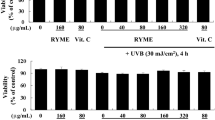Abstract
The inner shell of the chestnut (Castanea crenata S. et Z., Fagaceae) has been used as an anti-wrinkle/skin firming agent in East Asia, and preliminary experiments have found that a 70% ethanol extract from this plant material can prevent cell detachment of skin fibroblasts from culture plates. In order to examine the molecular mechanisms underlying this phenomenon, its effects on the expression of adhesion molecules, such as fibronectin and vitronectin, were investigated using the mouse skin fibroblast cell line, NIH/3T3. Using fixed-cell ELISA, Western blotting and immunofluorescence cell staining, it was clearly demonstrated that the chestnut inner shell extract enhanced the expression of the cell-associated fibronectin and vitronectin. Scoparone (6,7-dimethoxycoumarin), isolated from the extract, also possessed similar properties. These findings suggest that the enhanced expression of the adhesion molecules may be one of the molecular mechanisms for how the chestnut inner shell extract preventing cell detachment and may be also responsible for its anti-wrinkle/skin firming effect.
Similar content being viewed by others
References
Afek, U., Sztejnberg, A., and Carmely, S., 6,7-Dimethoxy-coumarin, a citrus phytoalexin conferring resistance againstPhytophthora gummosis.Phytochem., 25, 1855–1856 (1986).
Brown, L. F., Dubin, D., Lavigne, L., Logan, B., Dvorak, H. F., and Van de Water, L., Macrophages and fibroblasts express embryonic fibronectins during cutaneous wound healing.Am. J. Pathol., 142, 793–801 (1993).
Chi, Y. S., Cheon, B. S., and Kim, H. R., Effects of wogonin, a plant flavone from Scutellaria radix, on the suppression of cyclooxygenase-2 and the induction of inducible nitric oxide synthase in lipopolysaccharide-treated RAW 264.7 cells.Biochem. Pharmacol., 61, 1195–1203 (2001).
Dahlbach, K., Lofberg, H., and Dahlbach, B., Localization of vitronectin (S-protein of complement) in normal human skin.Acta Dermato-Venereol., 66, 461–467 (1986).
Grunt, T. W., Somay, C., Oeller, H., Dittrich, E., and Dittrich, C. H., Comparative analysis of the effects of dimethyl sulfoxide and retinoic acid on the antigen pattern of human ovarian adenocarcinoma cells.J. Cell Sci., 103, 501–509 (1992).
Huh, Z., Tang-aek, In Huh, Z. (Ed.).Dong-Eu-Bo-Gam (1613). Namsandang, Seoul, pp. 1160, 1966 (translated version).
Jang, Y. C., Tsou, R., Gibran, N. S., and Isik, F. F., Vitronectin deficiency is associated with increased wound fibrinolysis and decreased microvascular angiogenesis in mice.Surgery, 127, 696–704 (2000).
Klaus, H., Markku, K., Kari, A., Antti, V., Staffan, J., and Magnus, H., Isolation of the pericellular matrix of human fibroblast cultures.J. Cell Biol., 81, 83–91 (1979).
Kumazaki, T., Kobayashi, M., and Mitsui, Y., Enhanced expression of fibronectin during in vivo cellular aging of human vascular endothelial cells and skin fibroblasts.Exp. Cell Res., 205, 369–402 (1993).
Ladeda, V., Frankel, P., Feig, L. A., Foster, D. A., Bal de Kier Joffe, E., and Aguirre-Ghiso, J. A., RalA mediates v-Src, v- Ras and v-Raf regulation of CD44 and fibronectin expression in NIH3T3 fibroblasts.Biochem. Biophys. Res. Comm., 283, 854–861 (2001).
Mossman, T., Rapid colorimetric assay for cellular growth and survival: application to proliferation and cytotoxic assays.J. Immunol. Methods, 65, 55–63 (1983).
Phan, T. T., Allen, J., Hughes, M. A., Cherry, G., and Wojnarowska, F., Upregulation of adhesion complex proteins and fibronectin by human keratinocytes treated with an aqueous extract from the leaves ofChromolaena odora (Eupolin).Eur. J. Dermatol., 10, 522–527 (2000).
Pieraggi, M. T., Julian, M., Bouissou, H., Stacker, S., and Grimaud, J. A., Dermal aging. Immunofluorescence study of collagens I and III and fibronectin.Ann. Pathol., 4, 185–194 (1984).
Postlethwaite, A. E., and Kang, A. H., Fibroblasts and matrix proteins., In Gallin, J. I., and Snyderman, R. (Eds).Inflammation: Basic principles and clinical correlates. Lippincott Williams and Wilkins, Philadelphia, pp.227–257, (1999).
Ruoslahti, E., Fibronectin and its receptors.Ann. Rev. Biochem., 57, 375–413 (1988).
Schwartz, E., and Klingman, L. H., Topical tretinoin increases the tropoelastin and fibronectin content of photoaged hairless mouse skin.J. Invest. Dermat., 104, 518–522 (1995).
Shevitz, J., Jenkins, C. S., and Hatcher, V. B., Fibronectin synthesis and degradation in human fibroblasts with aging.Mech. Aging Develop., 35, 221–232 (1986).
Takeda, K., Gosiewska, A., and Peterkofsky, B., Similar, but not identical, modulation of expression of extracellular matrix components during in vitro and in vivo aging of human skin fibroblast.J. Cellular Physiol., 153, 450–459 (1992).
Xu, G., Niki, T., Virtanen, I., Rogiers, V., De Bleser, P., and Geerts, A., Gene expression and synthesis of fibronectin isoforms in rat hepatic stellate cells. Comparison with liver parenchymal cells and skin fibroblasts.J. Pathol., 183, 90–98 (1997).
Yang, M.-J., Kim, M. G., Lim, S., Ann, H.-J., and Ahn, R.-M., Inhibitory effects of water-acetone extracts of chestnut inner shell, pine needle and hop on the melanin biosynthesis.Yakhak Hoeji, 43, 494–501 (1999).
Author information
Authors and Affiliations
Corresponding author
Rights and permissions
About this article
Cite this article
Chi, Y.S., Heo, M.Y., Chung, J.H. et al. Effects of the chestnut inner shell extract on the expression of adhesion molecules, fibronectin and vitronectin, of skin fibroblasts in culture. Arch Pharm Res 25, 469–474 (2002). https://doi.org/10.1007/BF02976604
Received:
Issue Date:
DOI: https://doi.org/10.1007/BF02976604




